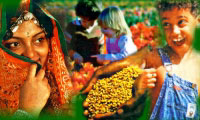 With 1,210,193,422 residents reported in the 2011 provisional census, India is the world’s second-most populous country. India’s population grew at 1.76% per annum during 2001–2011, down from 2.13% per annum in the previous decade (1991–2001). Population growth in India was 1.5% in 2006, compared to 1.72% in 1997.
With 1,210,193,422 residents reported in the 2011 provisional census, India is the world’s second-most populous country. India’s population grew at 1.76% per annum during 2001–2011, down from 2.13% per annum in the previous decade (1991–2001). Population growth in India was 1.5% in 2006, compared to 1.72% in 1997.
Current population for all countries, 2012
Source: United Nations, World Population prospects and US Census
(in thousands)
| Country | 2011-12 |
| China India USA Indonesia Brazil Pakistan Nigeria Russia Bangladesh Japan |
1,347,350 1,210,193 313,558 237,641 192,377 179,572 162,471 143,056 142,319 127,650 |
 India lives mainly in its villages, 638,000 of them. India has about 57 million urban and 136 million rural households. The number of Indians living in urban areas has grown by 31.2% between 1991 and 2001. Yet, in 2001, over 70% lived in rural areas. According to the 2001 census, there are 27 million-plus cities in India.
India lives mainly in its villages, 638,000 of them. India has about 57 million urban and 136 million rural households. The number of Indians living in urban areas has grown by 31.2% between 1991 and 2001. Yet, in 2001, over 70% lived in rural areas. According to the 2001 census, there are 27 million-plus cities in India.
India’s population highlights from Census 2011:
- Population growth rate: 1.312% (2012 est.)
- Median age: 26.2 years (male: 25.6 years; female: 26.9 years)
- Age structure: 0-14 years: 29.7%; 15-64 years: 64.9%; over 65 years: 5.5%
- Birth rate: 20.6 births/1,000 population. Was 48 births/ 1,000 population between 1911-1920
- Death rate: 7.43 deaths/1,000 population. Was 48 deaths/1,000 population between 1911-1920
- Infant mortality rate: total: 46.07 deaths/1,000 live births, declining from 151 to an estimated 88 per 1000 live births between 1965 and 1995.
- Total fertility rate: 2.58 children born/ woman
- Life expectancy at birth: 67.14 years (male: 66.08 years; female: 68.33 years); compared to 64 years in the 2002, compared with 68.59 years in 2007, 60 years in mid-1990’s and 27 years in 1947 and 20 years in 1911-1920.
- Spread across 28 states and 7 union territories, the Census covered 640 districts, 5,767 tehsils, 7,935 towns and 6,40,867 villages.
- The human sex ratio is 940 females per 1,000 males. The median age was 24.9 in the 2001 census.
- In 2008, 54% of urban and 21% or rural population had access to sanitation, compared to 44% of urban and 3% or rural population in 1990.
- There are around 60 physicians per 100,000 Indians.
- The Constitution of India recognizes 212 scheduled tribal groups which together constitute about 7.5% of the country’s population
- India is the 24th most densest populated country in the world.
World Population AD 1-2012
Source: World Almanac
| Year | Population (billions) |
| 1 1650 1850 1930 1975 1999 2001 2003 2007 2011 |
0.2 0.5 1 2 4 6 6.2 6.305 6.6 7 |
Population of the World’s Largest Cities
Source: World Atlas and UN
| City, Country | Pop. (thousands) 2010 |
Pop. (thousands) 2000 |
Pop. (thousands) 1995 |
| Tokyo, Japan Seoul, South Korea Mexico City, Mexico New York City, U.S. Mumbai (Bombay), India Jakarta, Indonesia Sao Paulo, Brazil Delhi, India Osaka, Japan Shanghai, China Buenos Aires, Argentina |
32,450 20,550 20,450 19,750 19,200 18,900 18,850 18,680 17,350 16,650 13,170 |
26,444 – 18,131 16,640 18,066 11,018 17,755 11,695 11,013 12,887 12,560 |
26,959 – 16,562 16,321 15,138 – 16,533 9,948 10,609 13,584 11,802 |
Notes: – The figures given here are United Nations estimates and projections, as revised in 1996, for “urban agglomerations” – that is, contiguous densely populated urban areas, not demarcated by administrative boundaries. These figures may not correspond to figures for cities in other parts of ‘The World Almanac’.
The World’s Refugees (in India)
Source: The World Refugee survey and Wikipedia
The earliest refugees to India were the Zoroastrians from Persia, from 12th century onwards. In the past 50 years, more than 150,000 Tibetans fled India, since the Chinese illegal occupation of Tibet.
Based on 1951 Census of displaced persons, 7.226 million Muslims went to Pakistan from India while 7.249 million Hindus and Sikhs (very few Muslims) were forced to move to India from Pakistan immediately after the partition of 1947 (about 78% of the population transfer was on the west). During the 1971 war of liberation of Bangladesh, 10 million refugees fled and have stayed in India.
| Origin (other than Bangladesh and Pakistan) | Total Numbers |
| Tibet, Sri Lanka, Burma, Afghanistan, Bhutan and other | 300,000 |
